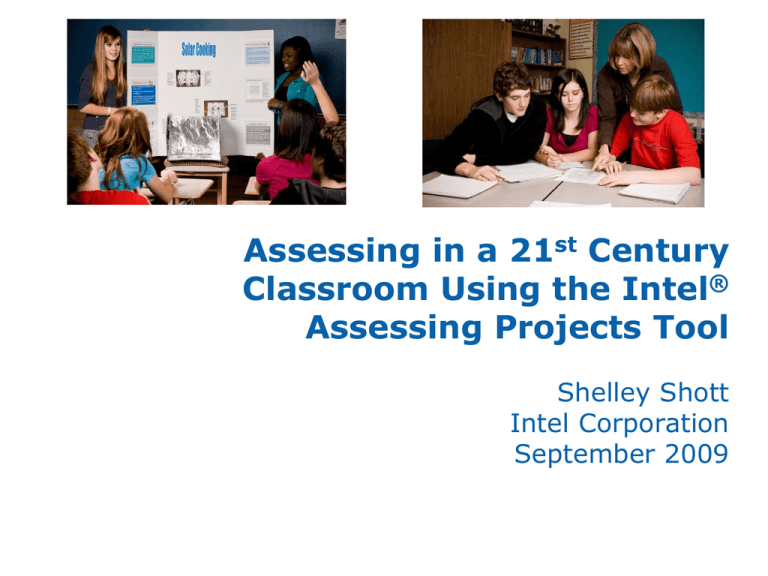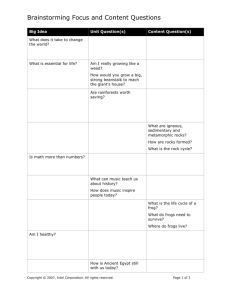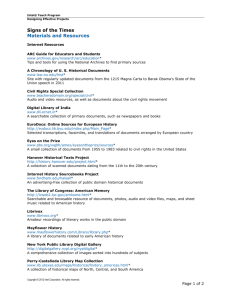
Assessing in a 21st Century
Classroom Using the Intel®
Assessing Projects Tool
Shelley Shott
Intel Corporation
September 2009
Goals of Presentation
1. To further our understanding of assessment
of 21st century skills by
• Exploring assessment purposes and strategies for 21st
century skills
• Examining the relationship between assessment and
instruction
2. To introduce an online assessment
resource: Assessing Projects
http://educate.intel.com/en/AssessingProjects
2
Assessment Defined
A broad process of collecting, synthesizing, and interpreting
information about student learning in the classroom.
The tests, performances, products that a student completes
to demonstrate knowledge, skills, and understanding. Also
the process a teacher uses to determine a student’s
knowledge, skills, or understanding.
• Assessment tools are what teachers and students use to complete
assessment processes
3
Research on New Assessment Practices
In classrooms where students were assessed regularly in
multiple ways, students showed considerable, even
substantial gains in learning
When classroom assessment is effectively implemented,
students show remarkable gains in achievement, 1 standard
deviation or more (Stiggins, 2004).
All students learn more, but low achievers benefit the most
(Black & Wiliam, 1998).
Self-assessment improves metacognition, which has the
greatest impact on achievement (Marzano, 1998).
4
Activity 1
Purposes of Classroom Assessment
1. Think about our purposes for Assessment
– Why do we assess?
2. Write down three purposes.
3. Share briefly with a partner
5
Activity 1
Purposes of Classroom Assessment
Compare your purposes to this list:
• Gauge students' prior knowledge
• Define and communicate learning targets to students
• Provide diagnostic feedback to teacher, student, and
parents
• Improve teaching effectiveness
• Identify students’ strengths and weaknesses
• Engage students in self-assessment
• Improve students' awareness of learning progress
Are there purposes that are not in this list?
6
Changing Assessment Practices
A student-centered classroom has a different
assessment scenario from the traditional classroom
• Tests and quizzes are still used but are not the only method of
assessing student learning.
Different types of assessment take place at multiple
points in a unit of study for different purposes.
For example:
• teachers and students give and receive feedback in the form of
peer and teacher conferencing
• checklists and rubrics help students understand expectations
and manage learning progress,
• self assessments encourage metacognition and ownership of
learning
• rubrics define quality for products that are assessed by peers
and the teacher
Intel® Innovation in Education – Asia Senior Trainers Conference 2005
7
7
© 2005 Intel Corporation. All rights reserved.
Activity 2
Changes in Classroom Assessment
Take a look at how one teacher has changed her
assessment practices
• Go to page 2 in the workbook
• Use the highlight tool and highlight the assessment
methods Ms. Perry has planned
• Go to page 4 and answer the questions
• Group share
8
Planning for Student-CenteredAssessment
• An assessment plan ensures a project stays focused
on intended learning goals and should be developed
along with project activities and tasks
• An assessment plan outlines methods and tools that
define clear expectations and standards for quality in
products and performances.
•It also defines project monitoring checkpoints and
methods to both inform the teacher and keep students
on track
Intel® Innovation in Education – Asia Senior Trainers Conference 2005
9
9
© 2005 Intel Corporation. All rights reserved.
When are Students Assessed?
Before Instruction
•
To gauge student needs
•
To survey students’ experience with the topic
•
To determine individual students’ interest
•
To set goals
10
When are Students Assessed?
During Instruction
•
To encourage self-direction and collaboration
•
To monitor progress
•
To check for understanding
•
To encourage metacognition
11
When are Students Assessed?
After Instruction
•
To demonstrate understanding and skill
•
To make connections among units and subjects
•
To reflect on learning in the unit and over time
•
To set and revise learning goals
12
Activity 3
Planning Assessment
Assessment Timeline: a planning tool for analyzing
effectiveness of an assessment plan
Intel® Innovation in Education – Asia Senior Trainers Conference 2005
13 © 2005 Intel Corporation. All rights reserved.
13
Activity 3
Assessment Timeline Analysis
Directions:
• Working in pairs, turn to page 6 of the workbook
and complete the two timelines
Romeo and Juliet Year 1
Romeo and Juliet Year 2
• Discuss with your partner which of these
assessments you use during your teaching
14
Activity 4
Methods of Assessment
There are many assessment methods each provides
information to both the teacher and students. Similar
assessment methods and tools may be used for different
purposes depending on how they are structured and what is
done with the results.
Review the methods in each category
1) Monitoring Progress
2) Check for Understanding or to Encourage Metacognition
3) Demonstrate Understanding and Skill
Indicate your interest or experience with each using:
I already use this method
+ I am interested in this method and want to try or use this more
– I am not interested in this method
? I don’t understand this method and need to know more
Think about how you will use those you are interested in trying
Intel® Innovation in Education – Asia Senior Trainers Conference 2005
15 © 2005 Intel Corporation. All rights reserved.
15
Activity 5
Assessing Thinking
The challenge:
How do we assess a process that goes on primarily inside
the brain?
• Help students see and understand their own thinking and
the thinking of others
• Use the products of students’ thinking, such as
reflections and graphic organisers
Intel® Innovation in Education – Asia Senior Trainers Conference 2005
16 © 2005 Intel Corporation. All rights reserved.
16
Activity 5
Assessing Thinking
1. Solve a problem in a group
2. Choose an observer to record the processes
used while the group works to solve the
problem.
–
–
–
3.
Observe the rest of the group solving the problem
Make check marks or brief comments when observing any of the behaviors
listed in the chart
Coach the group in problem-solving strategies not solving the problem
Check the thinking strategies you think the group
used and compare to researcher
Intel® Innovation in Education – Asia Senior Trainers Conference 2005
17 © 2005 Intel Corporation. All rights reserved.
17
Activity 5
Assessing Thinking
The Glass is Half Full
Quickly read through the following problem.
Two glasses are each filled half way, one with Pepsi, the other with Sprite. A
small amount of the Sprite is removed from the glass and put into the Pepsi
glass. The glass is stirred thoroughly so that the Sprite is completely mixed
into the Pepsi. Then the same amount of the mixture is removed form the
Pepsi glass and put back into the glass with the Sprite.
Question: After the soda has been exchanged, is there more Pepsi in
the Sprite glass or more Sprite in the Pepsi glass?
18
Intel® Innovation in Education – Asia Senior Trainers Conference 2005
© 2005 Intel Corporation. All rights reserved.
Activity 5
Assessing Thinking
Make an Educated Guess
Predict the solution.
• More Pepsi in the Sprite?
• More Sprite in the Pepsi?
• The same in both glasses
Intel® Innovation in Education – Asia Senior Trainers Conference 2005
19 © 2005 Intel Corporation. All rights reserved.
19
Activity 5
Assessing Thinking
Discuss these questions in a whole group:
• What was it like being observed? What was it like
observing?
• What if a teacher used this process to observe students?
What if a student used this to observe other students?
• How could this process be used in other subject areas?
Intel® Innovation in Education – Asia Senior Trainers Conference 2005
20 © 2005 Intel Corporation. All rights reserved.
20
Activity 6
Assessing Projects Web Resource
Content for integrating effective student assessment into
projects
• Examples, instructional strategies, theory
• How to use assessment to guide student learning
• Methods for developing effective assessments
An online application to create, edit and store rubrics,
scoring guides, and checklists
A database of validated assessments for 21st century skills
• Search by grade, subject, thinking skill, task
• Choose entire assessment or individual traits
• Edit rubrics into grade, subject, and project specific rubrics
Classroom units with assessment plans, assessment tools.
Intel® Innovation in Education – Asia Senior Trainers Conference 2005
21 © 2005 Intel Corporation. All rights reserved.
21
Activity 6
Assessing Projects Application
The Assessing Projects application creates rubrics, and
checklists.
Rubrics define quality work for students. Skills,
products, and performances have traits or dimensions
(the rows) with descriptors showing 4 levels of quality
or competency.
Scoring guides assign points to each level and may
offer detailed or more general descriptors
Checklists are used by the teacher for observation
and analysis of student work and by students to help
them monitor progress and self-evaluate.
22
Intel® Innovation in Education – Asia Senior Trainers Conference 2005
© 2005 Intel Corporation. All rights reserved.
Purposes of Assessment
The assessments in the Assessment Library provide formative and summative
assessments that
•
•
•
•
•
•
23
Gauge students' prior knowledge and readiness
Encourage self-direction and collaboration
Provide diagnostic feedback to teacher and student
Monitor progress
Check for understanding and encourage metacognition
Demonstrate understanding and skill
Entering Assessing Projects
Sign in to the
application with your
login ID or register if
you do not have a login
(note – same login as
Thinking Tools)
24
Assessing Projects Application
Landing Page
• Folders to keep
assessments you have
modified or created
• Folders containing
assessments in the
database
• click + to expand
• When a folder is
selected, short
descriptions of all its
assessments appear in
the right pane
• Area where assessment
descriptions appear
• Links to move through
the site
25
Browsing and Viewing Assessments
You can:
• Copy an
assessment to
your personal
library
• View the
assessment
• Export the
assessment
• Print Preview
26
Working with Personal Folders
When you identify assessments you would like to keep or modify, you can
organize them in folders and subfolders in your Personal Library.
Types of Assessments: Rubrics
4 Ratings
(high to low)
Interpretation Rubric - Elementary
4
Description
Traits
Personalization
Creativity
3
2
1
I describe the
most important
parts correctly
and in detail.
I describe the
most important
parts without
any mistakes.
I leave out
some important
parts and make
some mistakes
with the
information.
When I
describe the
information, I
make lots of
mistakes.
I explain many
ways in which the
information is
special to me.
I show how the
information is
special to me.
With help, I
describe a way
that the
information is
special to me.
I cannot
Descriptors
describe ways
or quality
that the
information is indicators
special to me.
My interpretation
surprises the
audience and
shows something
unusual and
important about
the information.
My
interpretation
shows
something
interesting and
important about
the information.
My
interpretation
shows expected
but important
information.
My
interpretation
shows only
expected
information.
Types of Assessments: Checklists
Creative Fluency Checklist – Middle School
Check
Comments
Student generates many ideas
about activities to do or objects
make.
Student uses several strategies to
think of ideas.
Student uses understanding of
subject area to generate ideas.
Student thinks of multiple ways to
reach a goal.
Student gets ideas from working
with peers.
Student helps peers think of
ideas.
List of items to be
observed or
completed
Columns for
checkboxes ,
dates, or comments
Types of Assessments: Scoring Guides
Insects Journal Scoring Guide
Traits are weighted to
emphasize the most important
components of a project.
Points are assigned to levels
of performance.
Although scoring guides may
be modified to be used as
formative assessments, they
are designed to assign points
or grades.
Modifying an Assessment: What can you do
You can:
• create assessment
• edit assessment
• each type of
assessment is a
little different to
edit
• print preview
• delete assessment
• send assessment
• export assessment
31
Creating an Assessment from Scratch
Change the font of the text to bold
or italic if you wish. You will need to
export your assessment to a word
processing program to make other
format changes.
32
• You title
your
assessment
• Choose the
type of
assessment
• Choose the
number of
columns
• Click
“apply” when
you are done
Exporting and Sharing an Assessment
To save an assessment to your personal computer, click Export.
Then, choose an application. You will be prompted to save and select
a destination on your computer.
To send an assessment to a colleague, type the colleague’s Teacher
ID in the box and click Send.
33
Editing Your Exported Assessment
•
•
•
•
•
•
34
Add customized headings with spaces for name, date, class, or subject
Change the color, size, and style of text
Change the colors, borders, or other properties of the table
Merge cells, rows, or columns to organize information
Embed useful documents within the assessment, such as guidelines for
citations or project tips
Add spaces for goal-setting, self-monitoring, and reflection
Activity 6
Your Assessing Projects Workspace
• Go to the Assessing Projects website
•
•
•
•
•
•
http://educate.intel.com/en/AssessingProjects
Browse Overview and Benefits
Watch the tutorial
Click on the Workspace tab
Log in or register
View some assessments that you think you might like to try
and put them into your library.
• Edit one of these assessments to meet your needs for your
classroom
– Create an assessment from scratch
35




